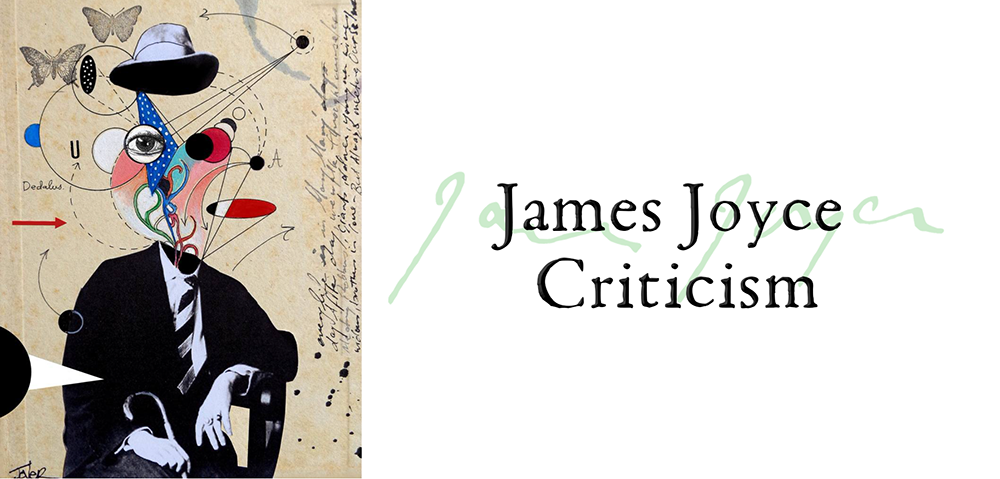Joyce Criticism – General 1: 1924-1979
- At June 29, 2022
- By Great Quail
- In Joyce
 0
0
General Joyce Criticism: 1924-1979
The works profiled below offer criticism about Joyce and his writing, rather than focusing on any specific novel. The books are listed by publication date. Clicking a cover image takes you to Amazon.com. When Brazen Head commentary is unavailable, the publisher’s summaries are usually reprinted. Many of these profiles contain links to detailed reviews published in the James Joyce Quarterly or other academic journals. Unfortunately, most of these are gated behind a JSTOR or Project MUSE paywall. If any knowledgeable Joyce reader would like to review, summarize, or provide additional information for any of these “uncommented” books, please drop us a line! Additional “general” criticism may be found by clicking the links below.
General Joyce Criticism
[Main Page | Criticism 1924-1979 | Criticism 1980-1999 | Criticism 2000-2019 | Criticism 2020-Present]
James Joyce: His First Forty Years
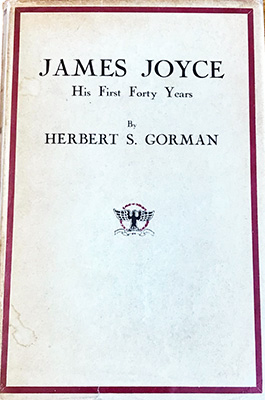
James Joyce: His First Forty Years
By Herbert S. Gorman
B.W. Huebsch, 1924
Current: Hassell Street Press, 2021
Available online at: Internet Archive
Herbert Sherman Gorman (1893-1954) was a Massachusetts-born editor, writer, and book reviewer. He lived in Greenwich Village, where his circle of friends included Stephen Vincent Benét, Theodore Dreiser, and Sinclair Lewis. Known for his historical novels, Gorman’s most famous book was The Scottish Queen (1932), a fictionalized life of Mary Queen of Scots. He also wrote The Place Called Dagon (1927), an early work of weird fiction mentioned by H.P. Lovecraft in his seminal Supernatural Horror in Literature, and believed to have influenced Lovecraft’s own fiction.
Widely recognized as James Joyce’s earliest biographer, Gorman’s first book about Joyce was James Joyce: His First Forty Years, which combined biography and commentary about Dubliners, Portrait, and Ulysses. (He spends a lot of time summarizing Ulysses, which was still unavailable to most of his readers!) Joyce was pleased by Gorman’s work, and mailed him a list of “rectifications” for the upcoming UK edition to be published by Geoffrey Bles. Although these corrections were ultimately not incorporated into the 1926 printing, Gorman worked closely with Joyce to publish a proper biography in 1939. (Visitors interested in Gorman and Joyce’s working relationship are directed to Hugh Witemeyer’s “He Gave the Name,” published in the James Joyce Quarterly.)
James Joyce and the Plain Reader

James Joyce and the Plain Reader
By Charles Duff
Desmond Harmsworth, 1932
Charles Duff (1894-1966) was an Anglo-Irish writer who worked for the Intelligence division of the British Foreign Office. Unsatisfied with Britain’s fascist sympathies in Spain, Duff retired from government service and pursued a career as a linguist, teacher, and writer. His involvement in early Joyce criticism was actually a response to a popular book published in 1927 by Robert Graves and Laura Riding, A Survey of Modernist Poetry. Attempting to demystify the work of Ezra Pound, T.S. Eliot, Gertrude Stein, and E.E. Cummings, Graves and Riding directed their survey to a hypothetical “plain reader,” one comfortable with Shakespeare, but put off by the eccentricities and obfuscations of Modernism. They challenged this reader to work a little harder and become an active participant in the project of Modernism itself:
What we have to do, then, is to discover whether or not the poet means to keep the public out. If, after a careful examination of poems that seem to be only part of the game of high-brow baiting low-brow, they still resist all reasonable efforts, then we must conclude that such work is, after all, merely a joke at the plain reader’s expense and let him return to his newspapers and to his Shakespeare (who we are for the moment assuming is understood without difficulty). But if, on the other hand, we are able to get out of these poems the experiences we are accustomed to expect of poetry, or at least see that the poet originally wrote them as poetry and not literary tricks, then the plain reader must make certain important alterations in his critical attitude. In the first place, he must admit that what is called our common intelligence is the mind in its least active state: that poetry obviously demands a more vigorous imaginative effort than the plain reader has been willing to apply to it.
Once this work has been done, the reader would discover that Modernist writing is not as difficult as it may initially appear, and still adheres to traditional themes. Graves and Riding mention Joyce, but only in passing, and their discussion of Ulysses is riddled with misperceptions and errors.
A few years later, Charles Duff took it upon himself to expand Joyce’s role in the Modernist pantheon, and by doing so rescue Ulysses from its burgeoning appropriation by critics, “a breed very heartily detested by Joyce.” The result was James Joyce and the Plain Reader, a self-described “essay” opening with an all-caps reference to Graves and Riding’s survey: “DEDICATED WITHOUT MALICE TO THE PLAIN READER.”
Right from the start, Duff separates himself from the class of literary critics and academics, expressing a prescient disdain for what would eventually become the professional Joyce industry. He insists that James Joyce is not only readable, but meaningful, and can be understood by anyone with a passing familiarity of Joyce’s Irish biography. Where Graves and Riding charged the “plain reader” to follow a method “that turns the reader into a poet,” Duff wrote, “I believe the plain reader to be more intelligent than the majority of reviewers think he is, or than he suspects himself.” Situating himself as a friendly guide, Duff was first in a long line of “friendly guides” to Joyce that includes this very Web site and projects like UlyssesGuide.com. It also helps that Duff is an enjoyable writer with a generous sense of humor: “I presume, Mr. plain reader, it has never been your experience to wander in a very drunken state into a Dublin house of ill-fame, so it may be a little difficult for you to appreciate this episode fully unless you are prepared to allow your mind free imaginative flight.”
For visitors interested in Duff’s fascinating attempt to popularize Joyce, I recommend “Modernism and the Plain-Reader’s Rights” by Jean-Michel Rabaté, published in European Joyce Studies in 2002. I’m greatly indebted to Rabaté’s research for the above summary. Rabaté also discusses Joyce’s reaction to Duff’s book, and contends that Joyce incorporated some of his ideas into Finnegans Wake.
James Joyce
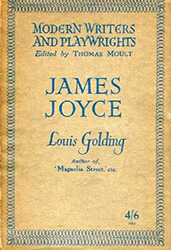
James Joyce
By Louis Golding
Thornton Butterworth, 1933
Louis Golding (1895-1958) was a British writer of Ukrainian descent. Influenced by Edgar Allan Poe, Golding wrote numerous poems, essays, travelogues, and bestselling novels. Leftist politics and Jewish themes were central to his work—his best-known novel is Magnolia Street, about working-class British Jews. He was also a veteran of World War I, an experience that informed his novel Honey for the Ghost, a tale of postwar trauma cast as a supernatural thriller. In 1933, Golding was tapped to write a book about James Joyce for Thomas Moult’s “Modern Writers and Playwrights” series. The jacket copy advertises James Joyce as:
A clear and simple summary of the works of the most controversial figure in modern literature. Mr. Holding deals with Joyce’s personal history and the development of his genius, and makes it possible for everyone to understand the method of his most original style of writing.
A Bibliography of James Joyce 1882-1941
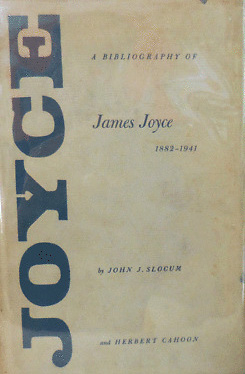
A Bibliography of James Joyce 1882-1941
By John J. Slocum & Herbert Cahoon
Yale University Press, 1953
John J. Slocum (1914-1997) was a Harvard graduate with an active political career. He worked as an aide for New York Mayor Fiorello la Guardia, served in the U.S. Air Force, and joined the U.S. Information Agency. He also pursued a side-career as a literary agent, and vigorously defended controversial writers such as Ezra Pound, Henry Miller, and Anaïs Nin. But his biggest project was assembling the “James Joyce Library,” a massive collection of Joycean material that eventually found a home at Yale’s Beinecke Library. Slocum worked tirelessly as James Joyce’s bibliographer, working with Harriet Shaw Weaver, Sylvia Beach, and Nora Joyce to assemble a comprehensive catalogue of Joyce’s pamphlets, articles, and manuscripts. In 1953 Slocum published A Bibliography of James Joyce 1882-1941. Co-edited by Henry Cahoon, who would later sit on the controversial Tanselle Committee established to investigate criticism of the Gabler “corrections” to Ulysses, the Bibliography was the result of “ten years of investigation, research, and preparation” into the world of James Joyce and the printed word. Although Slocum’s preface laments the incompleteness of the collection—not every translation could be found, and the book omits works of Joycean criticism and biography—perusing its table of contents reveals the broad scope of the project:
Contents:
A. Books and Pamphlets by James Joyce
B. Books and Pamphlets with Contributions by James Joyce
C. Contributions by James Joyce to Periodicals and Newspapers
D. Translations of Works by James Joyce
E. Manuscripts of James Joyce
F. Musical Settings of Works by James Joyce
G. Miscellany
Each entry in the Bibliography is fully annotated: publishing information, size, cost, etc. Most entries feature a detailed commentary derived from Slocum’s research. While the Bibliography is now obviously outdated, Slocum and Cahoon’s commentary remains relevant and informative, the foundation for eighty years of additional research!
Dublin’s Joyce
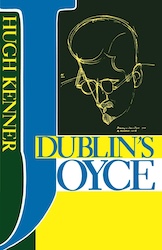
Dublin’s Joyce
By Hugh Kenner
First Edition: Chatto & Windus, 1955
Current: Columbia University Press, 1987
Available online at: Internet Archive
Hugh Kenner (1923–2003) was a Canadian scholar and critic who focused on Modernist literature, particularly the works of Ezra Pound, T.S. Eliot, James Joyce, and Samuel Beckett. Kenner was first introduced to Pound by his professor, the famous media philosopher Marshall McLuhan. Dublin’s Joyce was Kenner’s first book about Joyce, an extension of his Yale doctoral dissertation, James Joyce: Critique in Progress. It helped establish Kenner as one of the mid-century’s preeminent Joyceans. Indeed, finding a collection of Joyce essays without a contribution by Kenner is more of a puzzle than crossing Dublin without passing a pub!
Publisher’s Description: One of the most important books ever written on Ulysses, Dublin’s Joyce established Hugh Kenner as a significant modernist critic. This pathbreaking analysis presents Ulysses as a “bit of anti-matter that Joyce sent out to eat the world.” The author assumes that Joyce wasn’t a man with a box of mysteries, but a writer with a subject: his native European metropolis of Dublin. Dublin’s Joyce provides the reader with a perspective of Joyce as a supremely important literary figure without considering him to be the revealer of a secret doctrine.
Song in the Works of James Joyce
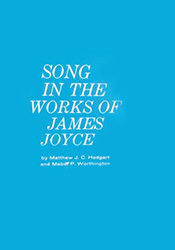
Song in the Works of James Joyce
By Matthew J. C. Hodgart and Mabel P. Worthington
Columbia University Press, 1959
A decorated veteran of World War II, Matthew John Caldwell Hodgart (1916-1996) was a British professor in the “eccentric” mold, known for a wide range of interests that included solving puzzles, collecting beach pebbles, and singing obscure English ballads. He was an expert in Volkswagen beetles, and wrote a “sequel” to Gulliver’s Travels that satirized political unrest on American campuses. Hodgart reputedly became familiar with Finnegans Wake by taking it to war, and is notable for being one of the first Joyce scholars to focus on Finnegans Wake rather than Ulysses. After publishing articles on Shakespeare, Vico, and foreign languages in the Wake, he turned his attention to music, a fascination that would produce two books. The first was Song in the Works of James Joyce, written with Temple University’s Mabel Worthington. The second was Joyce’s Grand Operoar: Opera In Finnegans Wake, written with Ruth Bauerle and published the year after his death. Hodgart also helped Roland McHugh with musical notes for McHugh’s Annotations to Finnegans Wake. (Ruth Bauerle published a heartfelt and informative obituary for Hodgart in the James Joyce Quarterly.)
Robert Martin Adams reviewed Song in the Work of James Joyce in the Hudson Review, Vol. 12, No. 4 (Winter, 1959-1960), pp. 627-632.
Mr. Matthew Hodgart of Cambridge and Miss Mabel Worthington of Temple University have cooperated on a revealing little book about Joyce’s use of song in his writing. It is a reference-type book, and a useful one, if necessarily short on literary charm. About three quarters of its modest bulk is given up to a page-and-line listing of song-snatches and song-references in Joyce’s works. The authors’ conclusions may be put in capsule form. Over four hundred songs are referred to or quoted in Ulysses; rather more than this number are in Finnegans Wake, and in the later book they are far more deeply worked into the text. The authors have performed a vast and impressive labor in winnowing through the golden acres of music-hall song, nursery rhyme, and operatic libretto; future students of the Joyce canon will find their work indispensable. To be sure, the arrangement of materials does not help us to go beyond the dictionary itself—to see, for example, what shape Joyce imposed on his materials, or where they came from. In the Calypso episode, for instance, Bloom contaminates the text of Lá ci darem most interestingly with another Mozart aria; but the index merely notes Lá ci darem. For the complicated line in Scylla and Charybdis, “Cordelia. Cordoglio. Lir’s loneliest daughter,” we are referred simply to “Silent, O Moyle.” A last complaint; songs are very adequately keyed to Joyce’s impressive materials of the bibliographies. A work so clearly destined for the use of students could have been rendered still more useful by adding a little extra bibliographical information to the description of each song. It is misleading, to say no more, that the Ballad of Joking Jesus is listed alongside the Ballad of Agincourt and the Ballad of Chevy Chase, as if all three were equally available in print.
James Joyce and the Common Reader
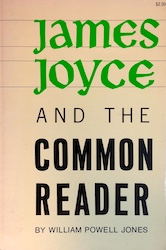
James Joyce and the Common Reader
By William Powell Jones
First Edition: University of Oklahoma Press, 1955
Second Edition: University of Oklahoma Press, 1970
A book-length expansion of a piece published in the American Scholar, William Jones’ James Joyce and the Common Reader is a simple guide to Joyce and his work—his “common reader” is even more average in taste and literary knowledge than Charles Duff’s “plain reader” of 1932. Focusing on Dubliners and Ulysses, Jones painstakingly illuminates Joyce’s techniques, intentions, and significance in easy-to-understand terms. His style is fresh and immediate, although sometimes condescending, and more sophisticated “common readers” may find themselves longing for a more comprehensive analysis. Jones devotes only one brief chapter to Finnegans Wake, claiming that the work is “too new to be thoroughly understood,” and that it’s certainly not for the “common reader” anyway. Still, James Joyce and the Common Reader serves as a solid, mid-century primer to Joyce, and makes some insightful points in language free from academic jargon.
A Reader’s Guide to James Joyce
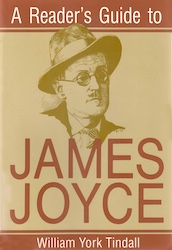
A Reader’s Guide to James Joyce
William York Tindall
First Edition: Noonday Press, 1959
Current: Syracuse University Press, 1995
Available online at: Internet Archive
William York Tindall (1903-1981) was a Columbia University professor who specialized in Irish literature. He first became interested in Joyce when he purchased a copy of Ulysses in Paris—on June 16, no less. Because Ulysses was still banned in the United States, Tindall smuggled the forbidden book through customs disguised by a fake cover. Nevertheless, in 1928 the young professor began assigning the book to his own students at New York University. He later wrote, “The dean of the school had one bootlegged copy, which he chained in the library, and students would read the chained edition.” In 1931 Tindall began teaching at Columbia University, a position he would hold for forty years.
Tindall is widely recognized as one of mid-century America’s most compelling advocates for Joyce. He was the third president of New York’s James Joyce Society, founded by John Slocum and currently the oldest Joyce organization in the world. While Tindall produced a copious amount of academic scholarship and literary criticism, he was especially known for his accessible “reader’s guides,” which attempted to bring Joyce to a wider audience. His Reader’s Guide to Finnegans Wake is still one of the best introductions to Joyce’s famously difficult novel. Tindall also wrote extensively about Samuel Beckett, and was instrumental in Beckett earning the Nobel Prize in 1969.
Bob Williams: In this book and its companion, The Reader’s Guide to Finnegans Wake, William York Tindall provides a lively look at Joyce’s prose fiction. This book is short (296 pages), and the average number of pages dedicated to each item is correspondingly brief. He covers Stephen Hero in three pages and barely more to the “Cyclops” chapter of Ulysses. In the hands of an intelligent writer this brevity has certain advantages. The intensity of focus gives a new and startling look to texts that often daunt and perplex the reader by their complexity. There have been more elaborate guides, few of them as well-written as this one, and books with special emphases but for the beginner and the advanced reader of Joyce this book is handy and pleasurable.
ReJoyce (Or: “Here Comes Everybody”)
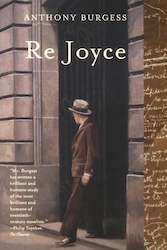
ReJoyce (Or: “Here Comes Everybody”)
By Anthony Burgess
First Edition: Press, 1965
Current: W.W. Norton, 2000
Available online at: Internet Archive
Anthony Burgess (1917-1993) is best known as the author of brilliantly imaginative novels such as A Clockwork Orange and Earthly Powers; but he’s also produced a substantial body of nonfiction, including studies of William Shakespeare, D.H. Lawrence, Ernest Hemingway, and James Joyce. An accomplished linguist, Burgess has published numerous translations, and even invented languages for Hollywood movies. And he’s written screenplays. And composed symphonies. And lived for a spell as a “tax exile,” driving a Bedford Dormobile around Europe. You know, the average life.
Anthony Burgess’ ReJoyce—titled in England as Here Comes Everybody: An Introduction to James Joyce for the Ordinary Reader—is one of my favorite books about Joyce. Of the many Joyceans who write for the “ordinary reader,” Burgess most closely reflects my own views on Joyce, views that set the tone for the Brazen Head. According to Burgess, ReJoyce “does not pretend to scholarship, only a desire to help the average reader who wants to know Joyce’s work but has been scared off by the professors.” Reassuring, but perhaps overly modest: Burgess’ work, though clear and easy to read, is never short on insight, and his understanding of Joyce is profound. Leaving explications, critiques, and walkthroughs to others, Burgess writes passionately in celebration of Joyce, a writer whose influence he’s never tried to conceal in his own novels, which abound in wordplay and narrative invention. Happily, his admiration for Joyce’s genius is leavened by a saucy sense of humor, a witty irreverence, and a guileless enthusiasm: ReJoyce is a fun book to read.
Burgess’ primary focus falls on Joyce’s revolutionary prose. This includes not only the structural and narrative innovations per se, but the psychological and aesthetic reasons behind them. Burgess sees Joyce as a Romantic engaged in a Humanist struggle: self-cast into the role of Daedalus, Joyce embarked on a quest to “rival the primal Creator” as he fashioned increasingly more complex worlds, each designed for the “ennoblement of the common man.” Burgess relates Joyce’s biography through the development of his writing, from the poems of a nine-year old Parnellite to the great Nightletter of Finnegans Wake. Each work is seen as Joyce’s response to a complex matrix of forces including family dynamics, the pressures of contemporary politics, the shifting role of literature in society, and the responsibilities of a writer to address these issues. Burgess sees a synergistic relationship between Joyce’s technique and the image of “reality” he was trying to reflect, a dialectical pressure forcing his prose into a state of continual evolution to meet changing demands. He demonstrates that each of Joyce’s books contains the seeds of the following work, and every resolution produced a more difficult set of problems demanding another quantum leap in language and style: “The roots of Ulysses are [in Portrait]—to every phase of the soul its own special language; Finnegans Wake must seem, not a wilful aberration from sense, but a logical conclusion to that premise.” True to this vision, ReJoyce unfolds beneath the shadow of the Wake, the “man-made mountain” and inevitable “terminus” for Joyce’s remarkable journey.
But ReJoyce is not just about technique. A book written by a great novelist in praise of another great novelist, ReJoyce further distinguishes itself from academic criticism by appealing directly to the reader’s heart. An impassioned—if occasionally cynical—humanist, Burgess frequently returns to themes of integrity, joy, and resurrection. He believes that Joyce’s work contains a “jocoseriousness” that elevates it above the vulgar and mundane, and makes a compelling case for Joyce’s universal humanity: Joyce should be shared by everyone, not kept to the scholars and the critics. Which isn’t to say that reading Joyce is easy! Burgess admits that Joyce offers a challenge—but part of being fully aware, fully alive, is saying “yes” to that challenge: “when we have read him and absorbed even one iota of his substance, neither literature nor life can ever be quite the same again. We shall be finding an embarrassing joy in the commonplace, seeing the most defiled city as a figure of heaven, and assuming, against all odds, a hardly supportable optimism.”
Joyce (Modern Masters)
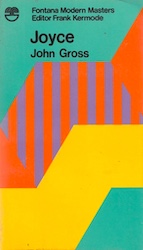
Joyce (Modern Masters)
By John J. Gross
Viking, 1970
The writer Bob R. Bogle, author of Up the Creek, shared this review with the Brazen Head:
I readily admit I wasn’t expecting too much from this little green paperback about James Joyce and his fiction; it’s a booklet of only 89 pages after all, plus end material, and it’s so small I could easily cart it about in my pocket and read it here and there at brief and intermittent interludes during a recent trip out of state. I was therefore surprised and pleasantly affected by John Gross’s sly and efficacious, even charming, style.
This is merely one installment from a popular 1970s series of publications on “Modern Masters”: study guides focused on writers and thinkers upon whom college students might be likely to be tested. This is a kind of precursor to more recent notes of the Cliffs or Spark variety, you might say, and in general that more ancient series is of a more refined and thoughtful order than what was to follow in ensuing decades, perhaps reflective of an era in which students were somewhat more concerned with learning for its own sake than simply and exclusively with passing tests.
In the first half of the book or so Gross provides us more with his own impressions of Joyce than with a tick-tock biography, painting us a non-chronological montage of the artist’s personality. Further on he does begin to take on Joyce’s artistic works in chronological order, and now this little reflective book grows a bit more formulaic, as we pass from Dubliners to Portrait to Ulysses and finally to Finnegans Wake, with the various lesser works included at their proper places. It seems to me that because Gross’s booklet is so short he is less successful here, but only because he lacks the space to tell his tale properly.
Still, this little guide booklet is, I think, a generally excellent one for ruminative undergraduates, perhaps, who are about to begin exploring Joyce’s infinitely complex world. Or, I might add, it is a friendly companion for those who are already familiar with Joyce, who only want a little light reading to carry with them on their next vacation.
Joysprick: An Introduction to the Language of James Joyce
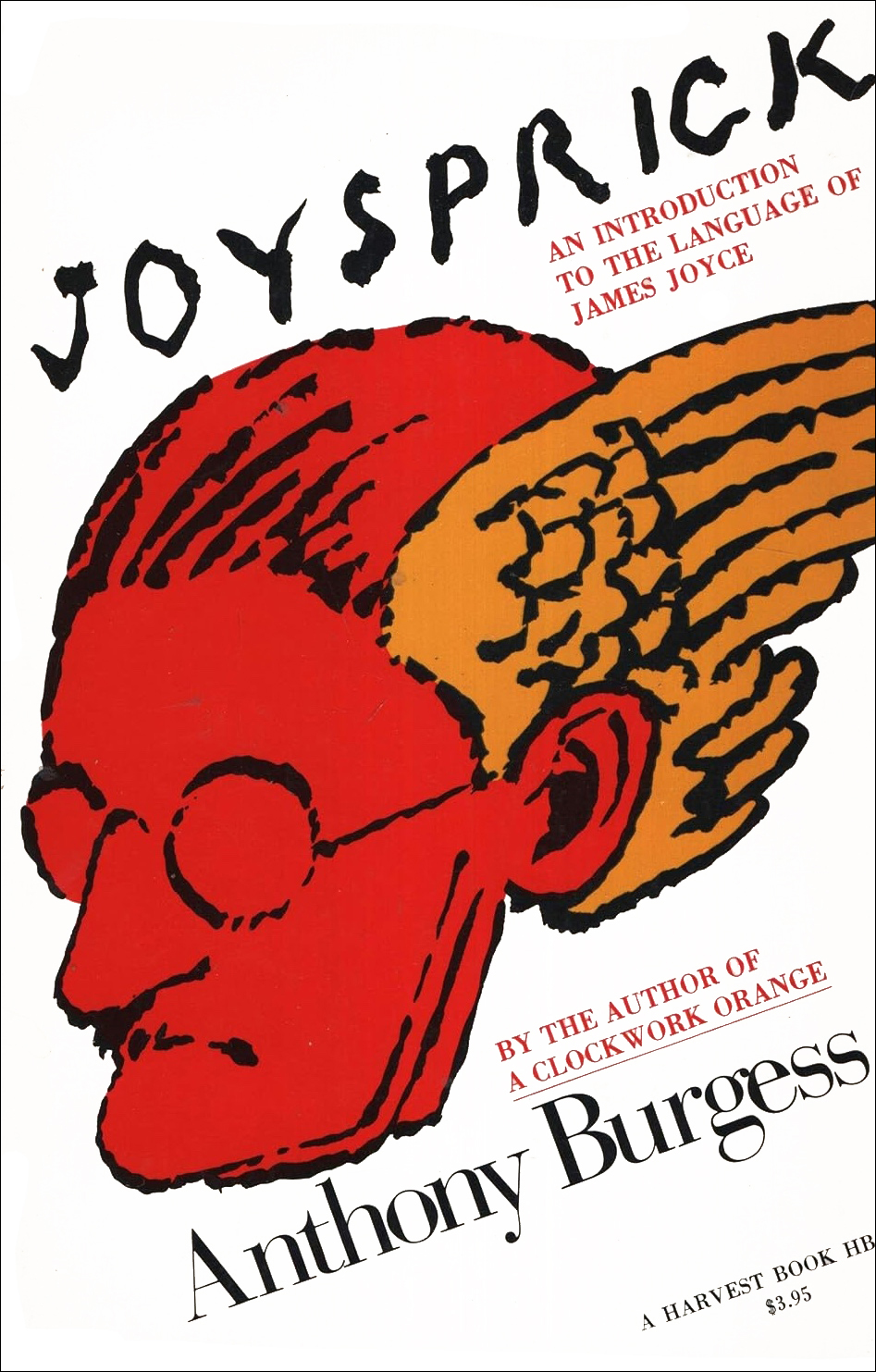
Joysprick
By Anthony Burgess
First Edition: Andre Deutsch, 1973
Paperback: Harcourt, 1975
Available online at: Internet Archive
After publishing A Shorter Finnegans Wake and ReJoyce, Anthony Burgess sharpened his focus on Joyce’s language in Joysprick. Despite Burgess’ long-standing fascination with Finnegans Wake, the primary focus here is Ulysses: “the fact is that in Ulysses there are many kinds of language, but in the Wake there is only one.” After a playful introduction teasing American scholars and their mechanical, lexicographical analysis of Joycean texts, Burgess explains that the true study of Joyce’s language must lead “into Joyce’s life, into the view of art which Joyce held and incarnated in his novels.”
Publisher’s Description: The innovator of the memorable Nadsat slang in A Clockwork Orange turns his attention to the language of James Joyce, an author with whom he has much in common, in this brilliant linguistic interpretation of Ulysses and Finnegans Wake, Stating that “any enquiry into Joyce’s use of language must end up in literary criticism, biography, general aesthetics,” Burgess leads the reader beyond linguistics into Joyce’s life and view of art. He sets out to answer two basic questions: How does Joyce use language, and why does he use it in the way he does? Burgess begins his book by rewriting the opening of Ulysses in the manner of a slick American author. He also employs his skills as a composer to discuss the musical analogies in Joyce’s work. He analyzes his cabalistic use of numbers, the visual quality of his constructions, the Joycean sentence, interior monologue, and the varied sources of Joyce’s style. He tells how to read some of the 100 character words in Finnegans Wake and, in the final chapter, traces Joyce’s debt to the vocabulary of Dublin’s lower depths.
Musical Allusions in the Works of James Joyce: Early Poetry through Ulysses
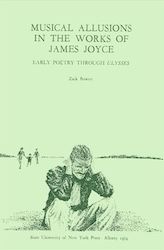
Musical Allusions in the Works of James Joyce: Early Poetry through Ulysses
By Zack Bowen
SUNY Press, 1974
Zack Bowen (1935-2010) was a larger-than-life Joycean with a raucous sense of humor and a passion for music. He served as the president of New York’s James Joyce Society as well as the International James Joyce Foundation. After ten years at the University of Delaware, Bowen relocated to the University of Miami so he could “fish year-round.” During his tenure as Chair of the Department of English from 1986-1996, Bowen developed Miami into robust center for Joyce studies, and served as editor of the famous Florida James Joyce Series from 1995 to 2004.
Publisher’s Description: Professor Bowen’s book is more than a simple collection of musical allusions; it is an engaging discussion of how Joyce uses music to expand and orchestrate his major themes. The introductions to the separate sections, on each of Joyce’s works, express a new and cohesive critical theory and reevaluate the major thematic patterns in the works. The introductory material proceeds to analyze the general workings of music in each particular book. The specific musical references follow, accompanied by their sources and an examination of the role each plays in the work. While the author considers the early works with equal care, the bulk of this volume explores the musical resonances of Ulysses, especially as they affect the style, structure, characterization, and themes. Like motifs in Wagnerian opera, some allusions introduce and later remind us of characters—bits of Molly’s songs for instance constantly intrude her impending adultery on Bloom’s consciousness. Other motifs are linked to concerns such as Stephen’s Oedipal guilt over his mother’s death, which in turn connects to his preoccupation with Shakespeare, the creator, the father, and the cuckold. Music helps create the bond which briefly joins Stephen and Bloom, and music augments the entire grand theme of consubstantiality. Professor Bowen’s style is simple and clear, allowing Joycean artifice to speak for itself.
Eric Sams reviewed Musical Allusions favorably in the Times Literary Supplement. An excerpt explains the book’s relationship to the work of Matthew Hodgart:
Musical Allusions in the Works of James Joyce has grown out of (but hardly outgrown) Song in the Works of James Joyce (1959) by Matthew Hodgart and Mabel P. Worthington. The latter is now writing a separate book on musical allusion in Finnegans Wake, so that topic is (by mutual agreement) omitted here, Despite this indebtedness and collaboration, Zack Bowen does not flinch from criticizing his 1959 source whenever he sees fit. With this true scholarly objectivity goes a similar determination not to miss anything of value, or indeed anything at all. To the 1,000 or so song-titles previously identified he has now added another eighty, of which perhaps a dozen are significant. But he is mainly concerned not with mere listing, but with explication. For each work (mainly Ulysses, with 309 pages out of 369) he gives a general introduction, then the text of each successive passage containing a musical allusion, then detailed commentary. One basic assumption is that Joyce’s citation of song-snippets implies a reference to the song itself, which then becomes available for critical exegesis.
James Joyce: A Collection of Critical Essays

James Joyce: A Collection of Critical Essays
Edited by William M. Chace
Prentice Hall, 1974
Available online at: Internet Archive
This collection offers the “usual suspects” of mid-century Joyce criticism—Hugh Kenner, Clive Hart, two essays by Richard Ellmann—along with pieces by more general critics like Hélène Cixous and Lionel Trilling.
Contents:
Dubliners
Hélène Cixous, “Political Ignominy—Ivy Day”
Richard Ellmann, “The Backgrounds of ‘The Dead’”
A Portrait of the Artist as a Young Man
Hugh Kenner, “The Portrait in Perspective”
Ulysses
Edmund Wilson, “James Joyce”
S.L. Goldberg, “Homer and the Nightmare of History”
Anthony Cronin, “The Advent of Bloom”
Richard Ellmann, “Why Molly Bloom Menstruates”
Finnegans Wake
Harry Levin, “The Language of the Outlaw”
Clive Hart, “Quinet”
Retrospection
Lionel Trilling, “James Joyce in His Letters”
Robert Martin Adams, “The Bent Knife Blade: Joyce in the 1960’s”
James Joyce (Literature in Perspective)
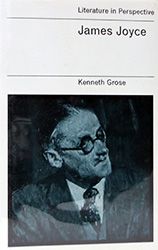
James Joyce (Literature in Perspective)
By Kenneth Grose
Rowman and Littlefield, 1975
Available online at: Internet Archive
Publisher’s Description: “Sure, if you’ve been married to the greatest writer in the world, you don’t remember all the little fellows.” In these words Nora Joyce dismissed the many literary and artistic figures, ornaments of the Modern Movement, who had been proud members of Joyce’s cosmopolitan circle. While Mrs Joyce’s naively expressed verdict may be pardonably exaggerated, Mr Grose makes it clear in this introductory study that no praise can be too high for Ulysses, a work of towering status. Mr Grose shows how Joyce’s single-minded pursuit of his aim of expressing the whole of a man’s mind began with preliminary sketches of real, sordid life in Dubliners, deepened into exploration of his own childhood and adolescence in A Portrait of the Artist as a Young Man, and culminated in the “farraginous all-including chronicle” which triumphantly combines an objective view of Dublin with the revelation of the most intimate motions of the mind. Hence Ulysses demands the closest attention, yet gives an ever intenser enjoyment with repeated readings. But this book does not neglect those works which seem to lie somewhat outside the above scheme: the pale imagist poems and the gripping obsessional drama, Exiles; and Mr Grose concludes his penetrating study with a short introduction to Finnegans Wake, which he finds virtually unreadable though (or perhaps because) the eccentric genius laboured on it for sixteen years. It is thus on Ulysses that Joyce’s claim to be “the greatest writer in the world” must rest, and this book shows why.
Joyce’s Voices
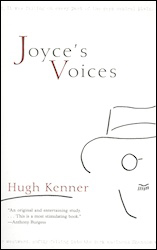
Joyce’s Voices
By Hugh Kenner
First Edition: University of California Press, 1978
Current: Dalkey Archive, 2007
Available online at: Internet Archive
Bob Williams: Hugh Kenner is a brilliant writer; but he might be a better writer if he were less brilliant. In Joyce’s Voices he notes the way in which Joyce allows the proximity of characters to influence with their inflections his narrative voice. Kenner, somewhat arbitrarily, calls this “the Uncle Charles principle,” a name which has stuck. Kenner elaborates on the element of parody in Joyce’s work and, less happily, insists upon an independent narrator whose purpose is to baffle the reader and to play tricks. Some decisions seem themselves to be marginal. Kenner decides for example that the apparition of Rudy at the end of “Circe” is solely for the reader and that Bloom (despite his speaking Rudy’s name) does not himself see Rudy. He bases this conclusion on the fact that Bloom neither mentions nor thinks of Rudy in the following chapters. This is a heavy burden for negative evidence to support. Any reader could multiply critical strictures but this short book is in the Joycean’s path, may not be avoided, is constantly entertaining and in many ways as enlightening as the more considered pronouncements of more conservative critics.
James Joyce and the Revolution of the Word
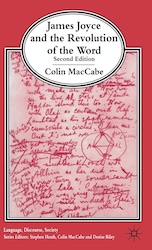
James Joyce and the Revolution of the Word
By Colin MacCabe
First Edition: Macmillan Press, 1978
Second Edition: Palgrave Macmillan, 2002
Available online at: Internet Archive
Born in 1949, Colin MacCabe is a British writer and film producer who currently teaches literature and film at the University of Pittsburgh. MacCabe received his PhD from Trinity College, his dissertation being James Joyce and the Revolution of the Word, which was published as a book in 1978. In 2003 the book was revised, expanded, and reissued by Palgrave Macmillan.
Publisher’s Description (2nd Edition): This second edition of Colin MacCabe’s James Joyce and the Revolution of the Word reprints a classic critical text on Joyce and adds a wealth of new material which places the text in its political and historical context. The argument links politics and literature, sex and language, to provide an account of Joyce which places him continually in both Irish and European history.
Contents:
- Theoretical Preliminaries
- The End of a Meta-Language: From George Eliot to Dubliners
- The End of the Story: Stephen Hero and A Portrait
- A Radical Separation of the Elements: The Distanciation of the Reader in Ulysses
- City of Words, Streets of Dreams: The Voyage of Ulysses
- A Political Reading of Finnegans Wake
- Joyce’s Politics
- Competence and Performance: The Body and Language in Finnegans Wake
- The Voice of Esau: Stephen in the Library
- Joyce and Benjamin
- Realism: Balzac and Barthes
CONTINUE TO > General Joyce Criticism 1980-1999
Joyce Criticism
[Main Page | General Criticism | Dubliners | Portrait | Ulysses | Finnegans Wake]
Author: Allen B. Ruch & Bob Williams
Artwork: Loui Jover
Last Modified: 15 June 2024
Main Joyce Page: The Brazen Head
Contact: quail(at)shipwrecklibrary(dot)com

